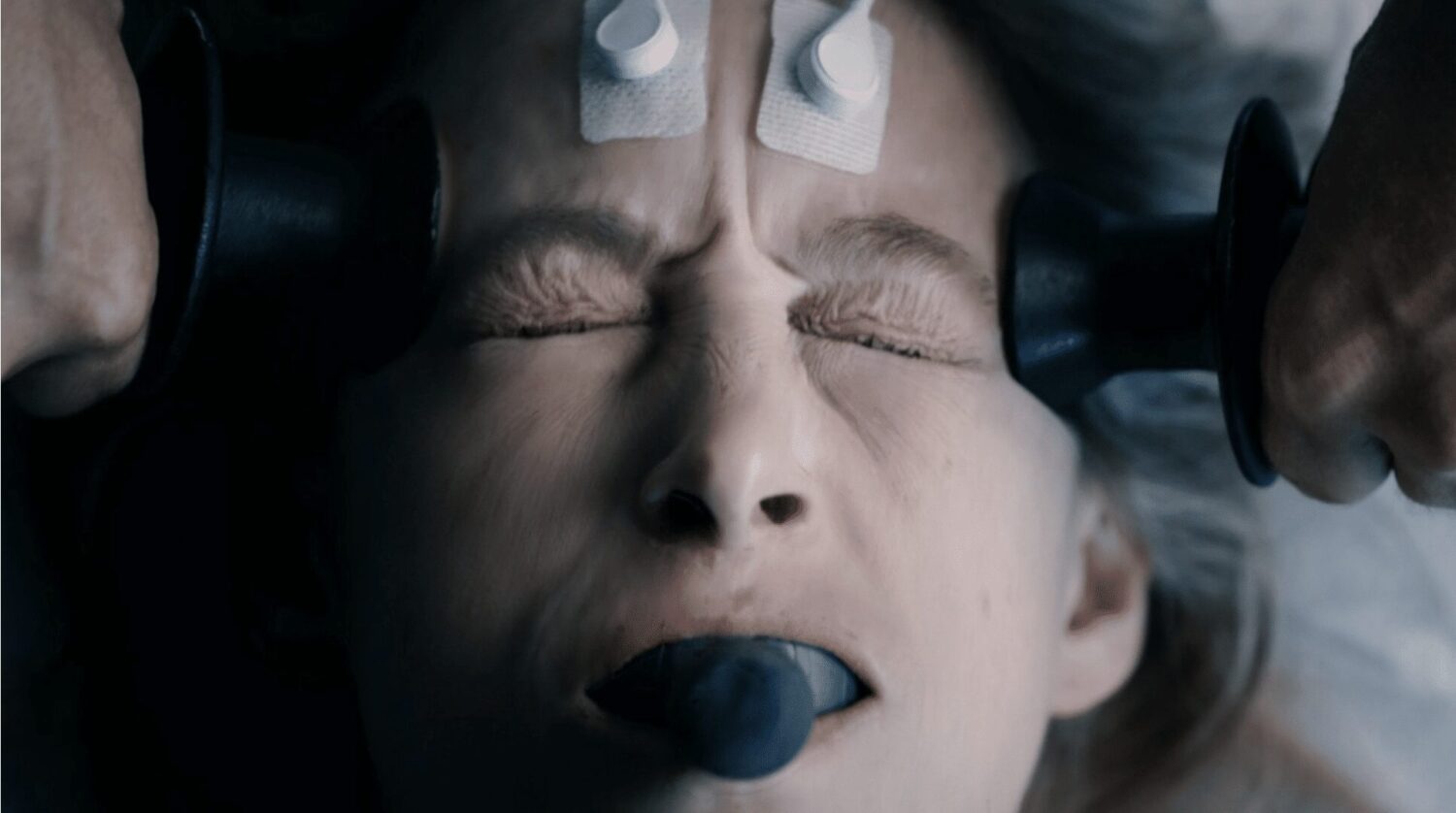Electroshock – In February 2013, the United Nations Special Rapporteur on Torture, Mr Juan Méndez, when speaking amongst other things, ECT (electroconvulsive therapy o electroshock) recommended an
“absolute ban on forced and non-consensual medical interventions against persons with disabilities, including the non-consensual administration of psychosurgery, electroshock and mind-altering drugs such as neuroleptics, [and] the use of restraint and solitary confinement, for both long- and short-term application.” [i]
REPORT OF THE SPECIAL RAPPORTEUR ON TORTURE AND OTHER CRUEL, INHUMAN OR DEGRADING TREATMENT OR PUNISHMENT
1 February 2013
39. …Medical care that causes severe suffering for no justifiable reason can be considered cruel, inhuman or degrading treatment or punishment, and if there is State involvement and specific intent, it is torture.
63. … It is essential that an absolute ban on all coercive and non-consensual measures, including restraint and solitary confinement of people with psychological or intellectual disabilities, should apply in all places of deprivation of liberty, including in psychiatric and social care institutions….
V. Conclusions and recommendations
- Significance of categorizing abuses in health-care settings as torture and ill-treatment
82. The prohibition of torture is one of the few absolute and non-derogable human rights, a matter of jus cogens, a peremptory norm of customary international law. Examining abuses in health-care settings from a torture protection framework provides the opportunity to solidify an understanding of these violations and to highlight the positive obligations that States have to prevent, prosecute and redress such violations.
B. Recommendations
85. The Special Rapporteur calls upon all States to:
Enforce the prohibition of torture in all health-care institutions, both public and private, by, inter alia, declaring that abuses committed in the context of health-care can amount to torture or cruel, inhuman or degrading treatment or punishment; regulating health-care practices with a view to preventing mistreatment under any pretext; and integrating the provisions of prevention of torture and ill-treatment into health-care policies;
4. Persons with psychosocial disabilities
89. The UN Special Rapporteur calls upon all States to:
Impose an absolute ban on all forced and non-consensual medical interventions against persons with disabilities, including the non-consensual administration of psychosurgery, electroshock and mind-altering drugs such as neuroleptics, the use of restraint and solitary confinement, for both long- and short-term application. The obligation to end forced psychiatric interventions based solely on grounds of disability is of immediate application and scarce financial resources cannot justify postponement of its implementation
“(d) Revise the legal provisions that allow detention on mental health grounds or in mental health facilities, and any coercive interventions or treatments in the mental health setting without the free and informed consent by the person concerned. Legislation authorizing the institutionalization of persons with disabilities on the grounds of their disability without their free and informed consent must be abolished.
14 May 2018: Statement by UN High Commissioner of the United Nations for Human Rights, Mr Zeid Ra’ad Al Hussein
“Psychiatric institutions, like all closed settings, generate exclusion and segregation, and being forced into one amounts to arbitrary deprivation of liberty. They are also, often, the locus of abusive and coercive practices, as well as violence potentially amounting to torture.”
“Forced treatment – including forced medication and forced electroconvulsive treatment, as well as forced institutionalisation and segregation – should no longer be practiced.”
Report of the United Nations High Commissioner for Human Rights United Nations (A/HRC/39/36) of 24 July 2018
Mental health and human rights
Report of the United Nations High Commissioner for Human Rights
44. In light of the discussions, the following recommendations were proposed.
46. States should ensure that all health care and services, including all mental health care and services, are based on the free and informed consent of the individual concerned, and that legal provisions and policies permitting the use of coercion and forced interventions, including involuntary hospitalization and institutionalization, the use of restraints, psychosurgery, forced medication, and other forced measures aimed at correcting or fixing an actual or perceived impairment, including those allowing for consent or authorization by a third party, are repealed. States should reframe and recognize these practices as constituting torture or other cruel, inhuman or degrading treatment or punishment and as amounting to discrimination against users of mental health services, persons with mental health conditions and persons with psychosocial disabilities. States should ensure their enjoyment and exercise of legal capacity on an equal basis with others by repealing laws that provided for substituted decision-making, and should provide: a range of voluntary supported decision-making mechanisms, including peer support, respectful of their individual autonomy, will and preferences; safeguards against abuse and undue influence within support arrangements; and the allocation of resources to enable and ensure the availability of support.
14 September 2018: Presentation of the UN High Commissioner on Human Rights thematic report Mental Health and Human Rights by UN Deputy High Commissioner for Human Rights, Ms. Kate Gilmore.
“PRACTICES SUCH AS FORCED TREATMENT, FORCED STERILIZATION AND FORCED INSTITUTIONALIZATION VIOLATE HUMAN RIGHTS, AS DOES THE CRIMINALIZATION OF THOSE WITH MENTAL HEALTH CONDITIONS.”
June 10, 2021: The World Health Organization’s “Guidance on Community Mental Health Services: Promoting Person-Centered and Rights-Based Approaches,”
The World Health Organization’s “Guidance on Community Mental Health Services: Promoting Person-Centered and Rights-Based Approaches,” condemns coercive psychiatric practices, which it says,
“are pervasive and are increasingly used in services in countries around the world, despite the lack of evidence that they offer any benefits, and the significant evidence that they lead to physical and psychological harm and even death.”[ii]
“Several other rights of the CRPD, including Freedom from torture or cruel, inhuman or degrading treatment or punishment and Freedom from exploitation, violence and abuse, also prohibit coercive practices such as forced admission and treatment, seclusion and restraint, as well as the administering of antipsychotic medication, electroconvulsive therapy (ECT) and psychosurgery without informed consent.”[iii]
Consultation on ways to harmonize laws, at the United Nations (A/HRC/49/29) of 2 February 2022
Summary of the outcome of the consultation on ways to harmonize laws, policies and practices relating to mental health with the norms of the Convention on the Rights of Persons with Disabilities and on how to implement them
Report of the United Nations High Commissioner for Human Rights
“40. In the light of the discussions, the United Nations High Commissioner for Human Rights makes the following observations and recommendations for States and all other relevant stakeholders, including health professionals, on ways to harmonize, as appropriate, laws, policies and practices relating to mental health with the provisions of the Convention on the Rights of Persons with Disabilities and on how to implement them:
“(c) Stemming from their obligations under the Convention, States should repeal provisions on forced institutionalization and substituted decision-making in law and in practice. States’ commitment to deinstitutionalization should include ending involuntary treatment practices,”
DRAFT GUIDANCE ON MENTAL HEALTH, HUMAN RIGHTS, AND LEGISLATION
June 2022
WHO/OHCHR
“Significant controversy surrounds the use of electroconvulsive therapy (ECT) and its associated risks (171). In Slovenia and Luxembourg, ECT is not available (172); and in many countries, there has been a dramatic decline in its use (173). Moreover, there are calls to consider banning ECT altogether (174, 175). If permitted, ECT must only be administered with the informed consent of the person concerned. International human rights standards are very clear that ECT without consent violates the right to physical and mental integrity and may constitute torture and ill-treatment (77). People being offered ECT should also be made aware of all its risks and potential short- and long-term harmful effects, such as memory loss and brain damage (176, 177).”
Box 24. What the law can say
WHERE ELECTROCONVULSIVE THERAPY CONTINUES TO BE PRACTICED, ITS ADMINISTRATION WITHOUT A PERSON’S PRIOR WRITTEN INFORMED CONSENT IS PROHIBITED.
171. Read J, Cunliffe S, Jauhar S, McLoughlin DM. Should we stop using electroconvulsive therapy? BMJ. 2019;364:k5233. doi: 10.1136/bmj.k5233.
172. Gazdag G, Takács R, Ungvari GS, Sienaert P. The practice of consenting to electroconvulsive therapy in the european union. J ECT. 2012;28:4-6. doi: 10.1097/YCT.0b013e318223c63c.
173. Read J, Harrop C, Geekie J, Renton J, Cunliffe S. A second independent audit of electroconvulsive therapy in england, 2019: Usage, demographics, consent, and adherence to guidelines and legislation. Psychol Psychother Theory Res Pract. 2021;94:603-19. doi: 10.1111/papt.12335.
174. Read J, Cunliffe S, Jauhar S, McLoughlin DM. Should we stop using electroconvulsive therapy? . BMJ. 2019;364:k5233. doi: 10.1136/bmj.k5233.
175. Breggin PR. Electroshock: Scientific, ethical, and political issues. Int J Risk Saf Med. 1998;11:5. (https://www.ectresources.org/ECTscience/Breggin_1998_ECT__Overview.pdf, accessed 27 June 2022).
176. Sackeim H, Prudic J, Fuller R, al. e. The cognitive effects of electroconvulsive therapy in community settings. Neuropsychopharmacol. 2007;32:244–54. doi: 10.1038/sj.npp.1301180.
177. Regulatory update to thymatron system iv instruction manual. Somatics; 2018 (https://www.thymatron.com/downloads/System_IV_Regulatory_Update.pdf accessed 27 June 2022 ).
[i] “Report of the Special Rapporteur on torture and other cruel, inhuman or degrading treatment or punishment, Juan E. Méndez,” UN Human Rights Council, 1 Feb.2013, https://www.ohchr.org/Documents/HRBodies/HRCouncil/RegularSession/Session22/A.HRC.22.53_English.pdf
[ii] “Guidance on Community Mental Health Services: Promoting Person-Centered and Rights-Based Approaches,” World Health Organization, 10 June 2021, https://www.who.int/publications/i/item/9789240025707 (to download report)
[iii] “Guidance on Community Mental Health Services: Promoting Person-Centered and Rights-Based Approaches,” World Health Organization, 10 June 2021, p. 7.















